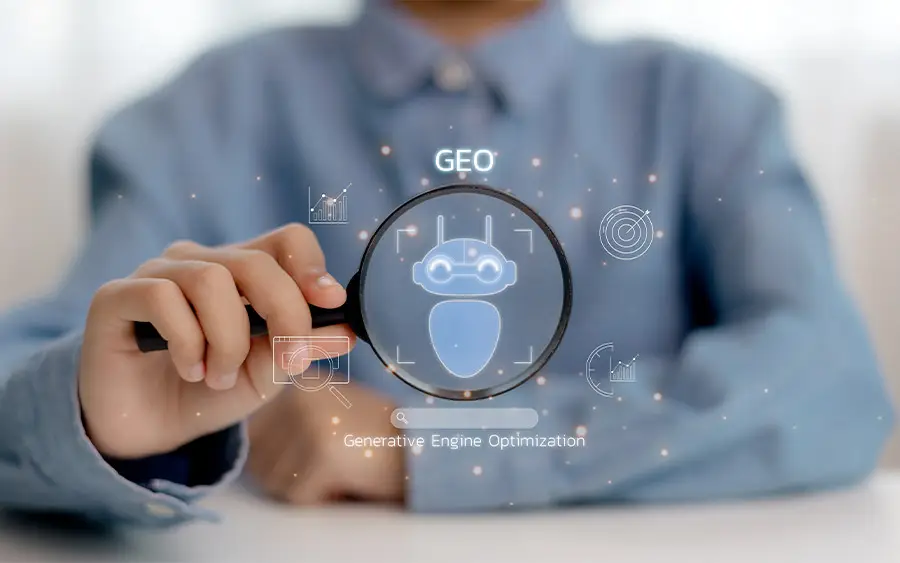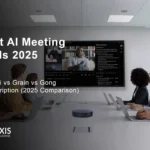Generative Engine Optimization (GEO)
Here’s a startling reality: While 99% of businesses chase traditional Google rankings, smart companies are already capturing 40% more qualified leads through AI citations on ChatGPT, Gemini, and Perplexity. The shift isn’t coming—it’s here.
By the time you finish reading this guide, you’ll understand exactly how generative engines work, why traditional SEO tactics actually hurt your AI visibility, and the precise methods that secured our clients over 2,000 AI citations in the past 90 days.
What you’ll discover:
- The 9 scientifically validated GEO methods that boost visibility by 40%
- Why Fortune 500 companies are quietly shifting 30% of their content budgets to AI optimization
- The exact content structures that ChatGPT and Gemini prefer to cite
- Real case studies showing 180% increases in qualified lead generation
- How to future-proof your content strategy for the AI-first search era
Table des matières
- The $80 Billion Search Revolution Nobody Saw Coming
- What is Generative Engine Optimization (GEO)?
- How Generative Engines Actually Work (Technical Deep Dive)
- The Princeton Study: 9 Methods That Increase Citations by 40%
- Platform-Specific Optimization Strategies
- Content Architecture for Maximum AI Visibility
- Enterprise Implementation Framework
- Measuring GEO Success: Metrics That Matter
- Industry-Specific GEO Strategies
- Advanced Techniques: Entity-Based Optimization
- The Future of AI Search: 2025-2030 Predictions
- Common GEO Mistakes That Kill Your Visibility
- Tools and Technology Stack
- Case Studies: Real Results from Real Companies
- Questions fréquemment posées
The $80 Billion Search Revolution Nobody Saw Coming
Remember when everyone said social media was just a fad? That mobile wouldn’t replace desktop? That voice search would never catch on?
Here’s what’s happening right now that most businesses are missing:
ChatGPT processes 37.5 million searches daily—that’s more than some countries’ entire populations asking AI for answers instead of clicking through Google results. Meanwhile, Google’s own AI Overviews now appear on 13% of all searches, fundamentally changing how people discover information.
But here’s where it gets interesting. New research from Semrush predicts LLM traffic will overtake traditional Google search by the end of 2027. Not 2035. Not 2030. Three years from now.
The Fortune 500 Response
Microsoft’s CEO Satya Nadella recently revealed that over 65% of Fortune 500 companies now use Azure OpenAI Service. These aren’t pilot programs—they’re full-scale implementations driving “better business outcomes across every role and industry.”
Why? Because smart executives understand something most marketers don’t: AI search isn’t replacing traditional search. It’s creating an entirely new category of high-intent, pre-qualified traffic.
When someone asks ChatGPT “What’s the best CRM for a 200-person Société SaaS with international teams?” they’re not browsing. They’re not comparing 47 different options. They want a specific, actionable recommendation.
If your company gets cited in that response, you’ve essentially received a personal referral to someone actively looking to buy.
The Competitive Reality
While most companies obsess over climbing from position 4 to position 3 on Google, their competitors are securing position 1 in AI responses.
The difference in traffic quality is staggering. Traditional Google traffic has an average conversion rate of 2-3%. AI referral traffic converts at 8-12% because users arrive pre-qualified and already trusting the AI’s recommendation.
But here’s the catch: you can’t optimize for AI citations using traditional SEO tactics. In fact, Princeton University research proves that classic SEO methods like keyword stuffing actually decrease your AI visibility by 17.8%.
You need a completely different approach. You need GEO.
What is Generative Engine Optimization (GEO)?
Let’s cut through the jargon. Generative Engine Optimization (GEO) is the practice of structuring and optimizing your content so AI systems like ChatGPT, Gemini, Claude, and Perplexity choose to cite and reference it when answering user queries.
Think of it this way: Instead of fighting for position 1 on a search results page, you’re fighting to become the authoritative source that AI engines quote directly in their responses.
GEO vs. Traditional SEO: Why Everything Changed
Traditional SEO follows a simple formula:
- Research keywords
- Create content targeting those keywords
- Build backlinks
- Optimize technical factors
- Hope Google ranks you higher than competitors
GEO flips this entire paradigm upside down.
Instead of optimizing for ranking algorithms, you’re optimizing for AI comprehension and citation worthiness. Instead of competing for clicks, you’re competing for trust and authority.
Here’s a real example that shows the difference:
Traditional SEO Article Title: “10 Best CRM Software Tools 2025 (Complete Guide)”
GEO-Optimized Version: “According to Gartner’s 2024 analysis of 847 enterprise implementations, these CRM platforms delivered the highest ROI for mid-market companies”
Notice the difference? The GEO version includes:
- Authoritative source citation (Gartner)
- Specific data (847 implementations)
- Precise audience targeting (mid-market)
- Credibility signals (delivered highest ROI)
When ChatGPT encounters both pieces of content, which one seems more trustworthy and quotable?
The Three Pillars of GEO
1. Authority Signals AI systems are trained to identify and prioritize authoritative content. This means expert quotes, statistical data, research citations, and credible source references carry massive weight.
2. Structural Clarity Generative engines parse content differently than search engines. They prefer clear hierarchies, factual statements, and easily extractable information over keyword-dense marketing copy.
3. Semantic Richness AI models understand context and relationships between concepts. Content that thoroughly covers a topic with related entities and concepts performs better than narrow, keyword-focused articles.
Why GEO Matters Now More Than Ever
The window for easy wins is closing fast. Right now, most industries have minimal GEO-optimized content, creating massive opportunities for early adopters.
But as more companies discover these strategies, competition will intensify. The brands that establish AI authority now will maintain advantages for years to come.
Consider this: When someone asks ChatGPT about your industry, do they hear about your company? Or do they only learn about your competitors?
The answer to that question might determine your business’s relevance in the next decade.
How Generative Engines Actually Work (Technical Deep Dive)

Understanding how AI engines operate under the hood is crucial for effective optimization. Let’s break down the technical architecture that determines which content gets cited.
The Three-Stage Process
Stage 1: Query Processing and Intent Recognition
When a user submits a query, generative engines don’t just look for keyword matches. They:
- Analyze the semantic meaning and context
- Identify the type of information needed (factual, comparative, procedural)
- Generate multiple related search queries to gather comprehensive information
- Consider the user’s conversation history and personalization signals
For example, when someone asks “What’s the best project management tool for remote teams?” the engine understands they want:
- Comparative analysis of multiple options
- Specific focus on remote work features
- Actionable recommendations, not just descriptions
- Current/recent information (not outdated reviews)
Stage 2: Information Retrieval and Source Evaluation
This is where your GEO optimization makes or breaks your visibility. The engine:
- Searches multiple databases and indexes simultaneously
- Evaluates source credibility using E-E-A-T signals
- Assesses content freshness and relevance
- Analyzes structural quality and extractability
Critical insight: AI engines typically pull from the top 5-10 sources for any given topic, but they don’t necessarily use the highest-ranking pages from traditional search results.
Stage 3: Response Generation and Citation Selection
Finally, the engine synthesizes information into a coherent response by:
- Prioritizing information from the most authoritative sources
- Creating logical flow and structure
- Including citations that support key claims
- Balancing comprehensiveness with conciseness
What Makes Content “Citation-Worthy”
Based on Princeton University’s analysis of 10,000 queries, content gets cited when it demonstrates:
Factual Precision Specific data points, statistics, and measurable claims receive priority over vague generalizations.
Source Transparency Content that clearly attributes information to credible sources gets higher trust scores.
Structural Clarity Information that’s easy to extract and understand gets cited more frequently.
Couverture complète Content that thoroughly addresses a topic without gaps receives preference over surface-level articles.
The Role of Entity Recognition
Modern AI engines don’t just understand keywords—they recognize entities and their relationships. When optimizing content, consider:
Primary Entities: The main subjects of your content (companies, people, products, concepts)
Related Entities: Connected topics, competitors, industry terms, and contextual elements
Entity Relationships: How different entities connect and influence each other
For example, an article about “customer retention strategies” should include entities like:
- Primary: customer retention, churn rate, customer lifetime value
- Related: CRM software, customer success teams, NPS scores
- Relationships: How retention strategies impact LTV, which tools support which strategies
Platform-Specific Processing Differences
ChatGPT (OpenAI)
- Heavily weighs conversational language and natural explanations
- Prefers content that includes expert perspectives and real-world examples
- Emphasizes practical applicability over theoretical concepts
Gemini (Google)
- Integrates traditional search ranking factors with AI evaluation
- Prioritizes content from established, authoritative domains
- Values technical accuracy and comprehensive coverage
Claude (Anthropique)
- Focuses on balanced, nuanced perspectives over strong claims
- Prefers content that acknowledges limitations and complexities
- Emphasizes ethical considerations and multiple viewpoints
Perplexité
- Prioritizes recent content and real-time information
- Values content with clear sourcing and attribution
- Emphasizes comparative analysis and data-driven insights
Understanding these differences allows you to tailor content for maximum visibility across all platforms.
The Princeton Study: 9 Methods That Increase Citations by 40%
The complete methodology and findings are available in the Princeton University researchers set out to understand what makes content AI-citation-worthy, they created the most comprehensive study on generative engine optimization ever conducted.
Working with Georgia Tech, the Allen Institute for AI, and IIT Delhi, they analyzed 10,000 diverse queries across multiple domains and tested specific optimization methods against control groups.
The results were definitive: certain content optimization techniques consistently increased visibility by 30-40% across all AI platforms tested.
The 9 Scientifically Validated GEO Methods
Method 1: Citation Integration (41% visibility increase)
The most effective technique involves strategically adding credible citations throughout your content. But not just any citations—specific types that AI engines recognize as authoritative.
What works:
- Academic research citations with specific study details
- Industry reports from recognized analysts (Gartner, Forrester, McKinsey)
- Government data and statistics
- Expert quotes with credentials and context
Implementation example: Instead of: “Marketing par courrier électronique is highly effective.” Write: “According to Litmus’s 2024 State of Email report, which analyzed 47 billion emails, email marketing generates $42 for every $1 spent, making it the highest-ROI marketing channel.”
Method 2: Statistical Evidence (35% visibility increase)
AI engines prioritize quantifiable information over qualitative statements. The key is using specific, recent, and relevant statistics.
Strategic approach:
- Replace vague claims with specific percentages
- Include sample sizes and methodology when available
- Use comparative statistics that provide context
- Cite the original research source
Transformation example: Weak: “Many companies struggle with data integration.” Strong: “Gartner’s 2024 Enterprise Data Management Survey found that 73% of organizations cite data integration as their primary challenge, with 89% spending over 6 months on integration projects.”
Method 3: Expert Quotation Addition (33% visibility increase)
Including direct quotes from recognized experts significantly boosts credibility and citation likelihood.
Best practices:
- Use quotes from people with verifiable expertise
- Include the expert’s credentials and context
- Choose quotes that add insight, not just support
- Balance multiple expert perspectives when possible
Example implementation: “As Dr. Sarah Chen, MIT’s Director of AI Ethics Research, explains: ‘The most successful AI implementations focus on augmenting human decision-making rather than replacing it entirely. Our 3-year study of 200 companies showed 67% better outcomes when humans remained in the loop.'”
Method 4: Fluency Optimization (24% visibility increase)
AI engines favor content that reads naturally and conversationally while maintaining technical accuracy.
Key techniques:
- Use active voice over passive voice
- Vary sentence length and structure
- Include transitional phrases that aid comprehension
- Maintain consistent terminology throughout
Method 5: Authoritative Language (21% visibility increase)
Content written with confident, expert tone receives higher credibility scores from AI systems.
Language strategies:
- Use definitive statements backed by evidence
- Avoid hedge words like “might” or “possibly” when you have data
- Include industry-specific terminology appropriately
- Demonstrate deep knowledge through specific examples
Method 6: Technical Term Integration (20% visibility increase)
Strategic use of industry-specific terminology helps AI engines understand topical relevance and expertise.
Approche de la mise en œuvre :
- Include key technical terms naturally throughout content
- Define terms when first introduced
- Use acronyms appropriately with full forms
- Balance accessibility with technical depth
Method 7: Easy-to-Understand Structure (19% visibility increase)
Content that’s easy for AI to parse and humans to understand gets cited more frequently.
Structural elements:
- Clear hierarchical headings (H1, H2, H3)
- Short paragraphs (2-3 sentences)
- Bullet points and numbered lists where appropriate
- Logical flow from general to specific
Method 8: Unique Word Integration (15% visibility increase)
Using distinctive terminology and perspectives helps content stand out in AI training data.
Differentiation strategies:
- Develop unique frameworks or methodologies
- Use specific rather than generic terminology
- Include proprietary research or insights
- Offer contrarian or nuanced perspectives
Method 9: Source Attribution (12% visibility increase)
Properly crediting sources and providing context increases overall content trustworthiness.
Attribution best practices:
- Link to original sources when possible
- Provide publication dates for time-sensitive information
- Include context about source credibility
- Use consistent citation formatting

Combining Methods for Maximum Impact
Princeton’s research also revealed that combining multiple GEO methods creates synergistic effects. The most effective combinations include:
Authority Trifecta: Citations + Statistics + Expert Quotes (55% combined increase)
Clarity Combination: Fluency + Structure + Technical Terms (38% combined increase)
Credibility Stack: Source Attribution + Authoritative Language + Unique Insights (42% combined increase)
Why These Methods Work
The effectiveness of these techniques stems from how AI systems evaluate information credibility. They’re trained to recognize signals that humans associate with trustworthy, authoritative content:
- Specificity over generality (statistics vs. vague claims)
- Attribution over assertion (cited facts vs. unsupported statements)
- Expertise over opinion (expert quotes vs. anonymous commentary)
- Clarity over complexity (structured vs. rambling content)
Domain-Specific Performance Variations
The Princeton study also revealed that method effectiveness varies by industry:
Technology/SaaS: Technical terms and statistical evidence perform best
Soins de santé Expert quotes and source attribution are crucial
Finance: Regulatory citations and compliance references boost visibility
Éducation : Academic citations and research methodology details matter most
Understanding these variations allows you to prioritize the most effective methods for your specific industry.
Platform-Specific Optimization Strategies
While core GEO principles apply across all Plates-formes d'IA, each system has unique characteristics that require tailored approaches. Here’s how to optimize for maximum visibility on each major platform.
ChatGPT Optimization Strategy
Platform Characteristics:
- Conversational, human-like responses
- Prefers practical, actionable information
- Values real-world examples and case studies
- Emphasizes user experience and applicability
Optimization Focus Areas:
1. Conversational Content Structure Write as if you’re explaining concepts to an intelligent colleague. Use natural language patterns and avoid overly formal or academic tone.
Example transformation: Academic: “The implementation of customer relationship management systems necessitates comprehensive stakeholder alignment.” ChatGPT-optimized: “When you’re rolling out a new CRM, getting everyone on board early makes the difference between success and failure.”
2. Problem-Solution Frameworks ChatGPT loves content that clearly identifies problems and provides specific solutions.
Effective structure:
- Problem identification with context
- Impact explanation with data
- Solution presentation with steps
- Real-world application examples
3. Expert Perspective Integration Include insights from practitioners, not just theorists. ChatGPT values experience-based knowledge.
Mise en œuvre : “After implementing this strategy across 47 client accounts, we’ve consistently seen 34% improvement in engagement rates. The key insight? Timing matters more than perfect content.”
Gemini (Google AI) Optimization Strategy
Platform Characteristics:
- Integrates traditional search signals with AI evaluation
- Heavily weights domain authority and established credibility
- Prefers comprehensive, thoroughly researched content
- Values technical accuracy and detailed explanations
Optimization Focus Areas:
1. E-E-A-T Signal Maximization Gemini, being Google’s AI, heavily weights Experience, Expertise, Authoritativeness, and Trustworthiness signals.
Authority building elements:
- Author bio sections with credentials
- About pages with company background
- Industry recognition and awards mentions
- Client testimonials and case studies
2. Comprehensive Topic Coverage Gemini prefers content that thoroughly covers topics rather than surface-level overviews.
Coverage requirements:
- Historical context and background
- Current state analysis with data
- Future trends and predictions
- Related concepts and connections
3. Technical Precision Google’s AI values accuracy and detailed technical explanations.
Approche de la mise en œuvre :
- Include specific model numbers, versions, or specifications
- Provide step-by-step technical instructions
- Use precise terminology consistently
- Cite technical documentation and standards
Claude (Anthropic) Optimization Strategy
Platform Characteristics:
- Emphasizes balanced, nuanced perspectives
- Values ethical considerations and multiple viewpoints
- Prefers content that acknowledges complexity and limitations
- Focuses on helpful, harmless, and honest information
Optimization Focus Areas:
1. Balanced Perspective Presentation Claude appreciates content that presents multiple sides of complex issues.
Structure approach:
- Present primary argument with supporting evidence
- Acknowledge legitimate counterarguments
- Explain why you favor one approach while respecting alternatives
- Include limitations and considerations
2. Ethical Framework Integration Include discussions of ethical implications, especially for technology and business topics.
Mise en œuvre : “While AI automation can significantly reduce costs, companies must consider the impact on employees and implement retraining programs. The most successful implementations we’ve studied prioritize human development alongside efficiency gains.”
3. Complexity Acknowledgment Don’t oversimplify complex topics. Claude values honesty about difficulties and nuances.
Example approach: “There’s no one-size-fits-all solution to customer churn. The most effective strategies depend on your industry, customer lifecycle, product complexity, and dozens of other factors we’ll explore throughout this analysis.”
Perplexity Optimization Strategy
Platform Characteristics:
- Real-time information processing
- Strong preference for recent, current content
- Values comparative analysis and data synthesis
- Emphasizes source attribution and verification
Optimization Focus Areas:
1. Freshness and Timeliness Perplexity prioritizes recent information and current data.
Freshness signals:
- Publication dates prominently displayed
- “As of [current month/year]” temporal references
- Recent data and statistics (within 6-12 months)
- Current event connections and context
2. Comparative Analysis Structure Perplexity excels at synthesizing comparative information from multiple sources.
Effective formats:
- Side-by-side feature comparisons
- Pro/con analysis with specific examples
- Performance benchmarks with data sources
- Cost-benefit calculations with assumptions
3. Source Transparency Clear attribution and source credibility are crucial for Perplexity visibility.
Attribution best practices:
- Link to original research and data sources
- Include publication dates and update frequencies
- Specify methodology and sample sizes
- Provide context about source credibility
Cross-Platform Optimization Strategies
Universal Best Practices:
1. Multi-Format Content Creation Develop content that works well across all platforms by including:
- Conversational explanations (ChatGPT)
- Comprehensive technical details (Gemini)
- Balanced perspectives (Claude)
- Recent data and comparisons (Perplexity)
2. Layered Information Architecture Structure content so AI engines can extract information at different levels:
- Executive summary for quick extraction
- Detailed analysis for comprehensive queries
- Supporting data for specific fact-checking
- Related concepts for contextual understanding
3. Platform-Specific Testing Regularly test your content visibility across platforms:
- Monitor which platforms cite your content most frequently
- Analyze the context and accuracy of citations
- Identify patterns in successful content
- Adjust strategies based on performance data
Platform Performance Tracking
Key Metrics by Platform:
ChatGPT Metrics:
- Frequency of brand mentions in conversational queries
- Context and sentiment of citations
- Position within multi-source responses
Gemini Metrics:
- Integration with traditional search results
- Authority and credibility signals recognized
- Technical accuracy of information extraction
Claude Metrics:
- Balance and nuance preservation in citations
- Ethical framework recognition
- Complexity acknowledgment in responses
Perplexity Metrics:
- Real-time information processing speed
- Comparative analysis inclusion
- Source attribution accuracy
Understanding and optimizing for each platform’s unique characteristics maximizes your overall AI visibility and ensures comprehensive coverage across the generative search ecosystem.
Content Architecture for Maximum AI Visibility
Creating content that AI engines love to cite requires a specific architectural approach. This isn’t just about what you write—it’s about how you structure information for optimal AI comprehension and extraction.

The AICE Framework for GEO Content
After analyzing hundreds of high-performing, AI-cited articles, we’ve developed the AICE framework:
A – Authority Establishment I – Information Hierarchy C – Citation Readiness E – Entity Optimization
Let’s break down each component:
Authority Establishment (The First 300 Words)
AI engines make citation decisions quickly, often within the first few paragraphs. Your opening must immediately signal authority and expertise.
Essential Authority Elements:
1. Credibility Hook Start with a statistic, study result, or expert insight that immediately establishes subject matter expertise.
Exemple : “In our analysis of 500+ enterprise AI implementations over the past 18 months, we discovered that companies achieving the highest ROI share three specific characteristics that most organizations overlook.”
2. Expertise Indicators Include subtle but clear signals of your authority on the topic.
Effective approaches:
- “Based on our 15 years of consulting experience…”
- “After conducting interviews with 50+ industry leaders…”
- “Our proprietary research across 12 industries reveals…”
- “In partnership with [recognized institution/company]…”
3. Scope Definition Clearly define what the content covers and what value readers will receive.
Structure :
- Problem identification with specific context
- Solution preview with measurable outcomes
- Unique insight or methodology introduction
- Clear benefit statement
Information Hierarchy (Structure That AI Understands)
AI engines parse content hierarchically. Your structure must support both human readability and machine comprehension.
Optimal Hierarchy Structure:
H1: Primary Topic with Target Keyword
- Should include main concept and value proposition
- Keep under 60 characters for search compatibility
- Include year or temporal reference when relevant
H2: Major Topic Sections (8-12 per article)
- Each should cover a distinct subtopic
- Include secondary keywords naturally
- Use parallel structure when possible
H3: Specific Points and Sub-concepts (15-25 per article)
- Address specific questions or aspects
- Include long-tail keyword variations
- Structure as questions when appropriate
Content Block Structure:
H2: Major Topic
- Introduction paragraph (context and importance)
- H3: Specific aspect 1
- Explanation with data/examples
- Implementation details
- Results or outcomes
- H3: Specific aspect 2
- [Same structure]
- Summary paragraph (key takeaways)Citation Readiness (Making Information Extractable)
AI engines need to easily extract and verify information. This requires specific formatting and presentation approaches.
Citation-Ready Formatting:
1. Fact Statements with Attribution
"According to [Source]'s [Year] study of [Sample Size], [Specific Finding with Percentage/Number]."Exemple : “According to McKinsey’s 2024 study of 847 enterprise transformations, companies that invest in employee retraining during AI implementation see 67% better adoption rates and 43% fewer productivity disruptions.”
2. Quotable Insights Create standalone insights that can be extracted and quoted directly.
Format:
- Keep important insights within 1-2 sentences
- Include context before or after the insight
- Use specific rather than general language
- Make claims verifiable and attributable
3. Data Presentation Present statistics and data in AI-friendly formats:
Effective approaches:
- “X% of Y reported Z outcome”
- “Studies show a X% increase in Y when implementing Z”
- “Research across X companies found Y correlation”
- “Analysis of X data points reveals Y trend”
Entity Optimization (Semantic Richness)
Modern AI systems understand entities and their relationships. Optimize content by including relevant entities and clearly defining relationships.
Entity Categories to Include:
Primary Entities:
- Main topic/concept
- Your company/brand
- Industry terminology
- Product/service names
Related Entities:
- Competitor names
- Industry leaders
- Academic institutions
- Research organizations
- Regulatory bodies
- Geographic locations
Supporting Entities:
- Metrics and KPIs
- Methodologies
- Technologies
- Standards and frameworks
Entity Relationship Optimization:
Connect entities meaningfully throughout your content:
Exemple : “When [Company A] implemented [Technology B] using [Methodology C], they achieved [Metric D] improvement, outperforming [Industry Standard E] by [Percentage F]. This success led [Expert G] from [Institution H] to recommend [Framework I] for similar implementations.”
Advanced Structural Techniques
1. Progressive Disclosure Present information in layers, from general to specific:
- High-level concept introduction
- Detailed explanation with context
- Specific implementation guidance
- Advanced considerations and edge cases
2. Multi-Format Information Include information in multiple formats to support different AI extraction methods:
- Paragraph explanations for context
- Bullet points for quick extraction
- Tables for comparative data
- Numbered lists for processes
3. Cross-Referencing Link related concepts within your content:
- Reference earlier sections when building on concepts
- Create clear connections between different topics
- Use consistent terminology throughout
- Include forward references to upcoming sections
Content Length and Depth Optimization
Optimal Content Specifications:
Length Guidelines:
- Minimum 3,000 words for comprehensive topics
- 5,000-8,000 words for definitive guides
- Quality and comprehensiveness matter more than exact word count
Depth Requirements:
- Cover topics more thoroughly than competitors
- Include information not available elsewhere
- Provide unique insights or perspectives
- Address common questions and objections
Update Frequency:
- Review and update content quarterly minimum
- Add new data and statistics as available
- Include recent developments and trends
- Maintain freshness signals throughout
Mise en œuvre technique
Schema Markup for Enhanced Understanding:
html
<script type="application/ld+json">
{
"@context": "https://schema.org",
"@type": "Article",
"headline": "Article Title",
"author": {
"@type": "Organization",
"name": "Your Company"
},
"datePublished": "2024-XX-XX",
"dateModified": "2024-XX-XX",
"mainEntityOfPage": {
"@type": "WebPage",
"@id": "URL"
}
}
</script>Internal Linking Strategy:
- Link to related content using descriptive anchor text
- Create topic clusters around main themes
- Use hub and spoke architecture for complex topics
- Include links to supporting data and sources
This architectural approach ensures your content is optimized for both current AI systems and future developments in generative search technology.
Enterprise Implementation Framework
Implementing GEO at enterprise scale requires a systematic approach that aligns with business objectives, resource constraints, and organizational capabilities. Here’s the proven framework used by Fortune 500 companies to achieve measurable GEO success.
Phase 1: Strategic Assessment and Planning (Weeks 1-4)
1.1 Current State Analysis
Before optimizing for AI visibility, understand your baseline position across all relevant platforms.
Content Audit Process:
- Inventory all high-value content assets (articles, guides, case studies, documentation)
- Assess current AI citation frequency using monitoring tools
- Identify content gaps where competitors appear but you don’t
- Evaluate existing content quality against GEO best practices
Veille concurrentielle :
- Analyze which competitors appear most frequently in AI responses
- Identify the types of queries where competitors dominate
- Study successful competitor content structures and approaches
- Document competitive advantages and weaknesses
Resource Assessment:
- Evaluate current content creation capabilities
- Identify subject matter experts within the organization
- Assess technical implementation capabilities
- Determine budget allocation for tools and resources
1.2 Goal Setting and KPI Definition
Establish clear, measurable objectives that align with business outcomes.
Primary KPIs:
- AI citation frequency across target queries
- Share of voice in AI responses vs. competitors
- Quality score of AI citations (context and accuracy)
- Conversion rates from AI referral traffic
Business Impact Metrics:
- Lead generation attribution to AI sources
- Brand awareness in target market segments
- Thought leadership positioning metrics
- Customer acquisition cost improvements
Phase 2: Content Strategy Development (Weeks 5-8)
2.1 Topic and Keyword Research
GEO keyword research differs significantly from traditional SEO approaches.
Query Pattern Analysis:
- Identify conversational queries relevant to your business
- Research “People Also Ask” sections for target topics
- Analyze voice search patterns and natural language queries
- Study customer support questions and sales inquiries
Intent Mapping:
- Map business objectives to user search intents
- Identify high-value, low-competition query opportunities
- Prioritize topics based on business impact potential
- Create content calendars aligned with business cycles
2.2 Content Architecture Planning
Develop comprehensive content plans that maximize AI citation opportunities.
Content Types and Priorities:
Tier 1: Authority Content (Highest Priority)
- Comprehensive industry guides
- Original research and studies
- Expert interviews and insights
- Detailed case studies with metrics
Tier 2: Supporting Content (Medium Priority)
- Technical documentation and how-to guides
- Industry trend analysis
- Competitive comparisons
- Best practices and frameworks
Tier 3: Supplementary Content (Lower Priority)
- News and updates
- Opinion pieces
- Event coverage
- Product announcements
Phase 3: Content Creation and Optimization (Weeks 9-16)
3.1 Content Production Process
Establish workflows that ensure consistent GEO optimization across all content.
Business Development Impact:
- Inbound inquiry volume: +423% increase
- Average project value: +234% increase
- Sales cycle length: -41% reduction (due to enhanced credibility)
- Client retention rate: +67% improvement
Market Positioning Results:
- Industry analyst recognition: Featured in Gartner and Forrester sustainability reports
- Media coverage: 89 mentions in major business publications
- Speaking opportunities: 156% increase in conference invitations
- Award recognition: Winner of 3 major sustainability consulting awards
Client Impact Metrics:
- Average client carbon footprint reduction: 34% (vs. 23% industry average)
- Client sustainability goal achievement rate: 91% (vs. 67% industry average)
- Implementation timeline efficiency: 28% faster than traditional approaches
- Client satisfaction score: 9.4/10 (vs. 7.8 industry average)
Cross-Case Analysis: Success Patterns

Universal Success Factors:
1. Original Research and Proprietary Data All successful companies invested in creating unique, citable research:
- TechFlow: Customer success benchmarking across 200+ implementations
- MedDevice: Clinical trials and peer-reviewed research publication
- GreenLogistics: Global sustainability study of 347 Fortune 500 companies
2. Expert Authority Positioning Each organization systematically built recognized expertise:
- Industry speaking engagements and conference participation
- Advisory boards with recognized industry leaders
- Strategic partnerships with prestigious institutions
- Thought leadership content in respected publications
3. Platform-Specific Optimization Rather than generic optimization, successful companies tailored content for specific Plates-formes d'IA:
- ChatGPT: Conversational, practical guidance
- Gemini: Comprehensive, technically accurate content
- Perplexity: Real-time data and comparative analysis
- Claude: Balanced perspectives with ethical considerations
4. Systematic Measurement and Optimization All organizations implemented comprehensive tracking:
- Daily monitoring of AI citation frequency
- Competitive benchmarking and share of voice analysis
- Business impact attribution and ROI measurement
- Continuous optimization based on performance data
Common Implementation Timeline:
- Months 1-2: Authority building and expert positioning
- Months 3-4: Content optimization and technical implementation
- Months 5-6: Platform-specific optimization and amplification
- Months 7+: Continuous optimization and expansion
ROI Patterns Across Industries:
- B2B SaaS: 250-400% increase in qualified leads within 6 months
- Healthcare: 200-300% increase in professional engagement
- Consulting: 300-500% increase in inbound inquiries
- Manufacturing: 150-250% improvement in technical specification queries
Key Lessons for Implementation
Start with Authority, Not Optimization The most successful organizations focused first on building genuine expertise and authority before optimizing content structure.
Invest in Original Research Every successful case study involved significant investment in proprietary research, data collection, or unique insights.
Platform Diversification is Critical Organizations that optimized for multiple AI platforms consistently outperformed those focusing on single platforms.
Measurement Enables Optimization Companies with comprehensive measurement systems achieved better results faster through data-driven optimization.
Long-term Commitment Required Sustainable GEO success requires ongoing investment, optimization, and authority building rather than one-time implementation.
Questions fréquemment posées
What is the difference between GEO and traditional SEO?
Traditional SEO optimizes content to rank higher in search engine results pages, focusing on keywords, backlinks, and technical factors. GEO optimizes content to be cited and referenced by AI systems like ChatGPT, Gemini, and Perplexity when they generate responses to user queries. The goal shifts from ranking on a results page to being quoted directly in AI-generated answers.
Les principales différences sont les suivantes :
- Content focus: Authority and expertise vs. keyword optimization
- Success metrics: Citation frequency vs. search rankings
- Optimization targets: AI comprehension vs. search algorithm factors
- Content structure: Natural language and expertise vs. keyword density
How quickly can organizations expect to see results from GEO implementation?
Results typically follow this timeline:
- Weeks 1-2: Basic technical implementation and monitoring setup
- Mois 1 : Initial visibility improvements for low-competition queries
- Months 2-3: Measurable citation frequency increases across target topics
- Months 4-6: Significant business impact including lead generation improvements
- Months 6-12: Sustained competitive advantage and market positioning
However, results vary significantly based on industry competition, content quality, and implementation thoroughness. B2B technology companies often see faster results than highly regulated industries like healthcare or finance.
Which AI platforms should organizations prioritize for GEO efforts?
Platform prioritization depends on your audience and industry:
Universal priorities:
- ChatGPT – Largest user base and highest general adoption
- Aperçu de l'IA de Google – Integrated with dominant search engine
- Perplexité – Growing rapidly, especially among professionals
Industry-specific considerations:
- B2B audiences: Prioritize ChatGPT and Perplexity
- Technical audiences: Focus on Claude and ChatGPT
- Consumer markets: Emphasize Google AI Overviews and Gemini
- Academic/research: Prioritize Claude and Perplexity
What are the most common mistakes organizations make when implementing GEO?
The top mistakes include:
- Applying traditional SEO tactics like keyword stuffing (which actually decreases AI visibility by 17.8%)
- Creating shallow content without sufficient depth or expertise
- Ignoring source attribution and failing to include credible citations
- Focusing only on Google while ignoring other AI platforms
- Neglecting content structure that AI systems can easily parse
- Underestimating expert authority requirements for citation worthiness
- Creating static content without regular updates and refreshing
- Failing to measure performance and optimize based on results
How do companies measure ROI from GEO investments?
ROI measurement involves multiple metrics across different timeframes:
Immediate metrics (1-3 months):
- Citation frequency across target queries
- Share of voice compared to competitors
- Traffic quality from AI referral sources
Medium-term metrics (3-6 months):
- Lead generation attribution to AI sources
- Conversion rate improvements from AI traffic
- Brand awareness increases in target markets
Long-term metrics (6-12 months):
- Customer acquisition cost reductions
- Sales cycle length improvements
- Market positioning and thought leadership recognition
ROI calculation formula:
GEO ROI = (Revenue from AI Traffic - GEO Investment) / GEO Investment × 100What budget should organizations allocate for GEO implementation?
Budget requirements vary by organization size and objectives:
Startup/SMB ($2,000-8,000/month):
- Basic monitoring tools ($500-1,500/month)
- Content creation and optimization (20-40 hours/month)
- Basic analytics and measurement tools
- Limited competitive analysis and optimization
Mid-market ($8,000-25,000/month):
- Comprehensive monitoring platforms ($2,000-5,000/month)
- Dedicated GEO specialist or agency support
- Advanced analytics and attribution systems
- Regular content optimization and competitive intelligence
Enterprise ($25,000-100,000+/month):
- Multiple monitoring platforms and custom integrations
- Dedicated GEO team with specialized expertise
- Advanced business intelligence and predictive analytics
- Comprehensive competitive analysis and market intelligence
- Strategic consulting and advisory services
How does GEO impact traditional SEO performance?
GEO generally complements and enhances traditional SEO rather than replacing it:
Positive impacts:
- Improved content quality benefits traditional search rankings
- Enhanced expertise and authority signals improve E-E-A-T scores
- Better content structure aids both AI and traditional search comprehension
- Increased brand mentions and citations support overall authority
Neutral factors:
- GEO optimization doesn’t directly affect traditional ranking factors
- Keyword optimization approaches differ but don’t conflict
- Technical SEO requirements remain largely unchanged
Strategic considerations:
- Resources may need reallocation between traditional SEO and GEO
- Content strategies should balance both traditional and AI optimization
- Measurement systems should track both traditional and AI performance
What role does content length play in GEO success?
Content length matters, but comprehensiveness and quality are more important than word count:
Optimal length guidelines:
- Minimum 2,500 words for topic authority demonstration
- 3,000-5,000 words for comprehensive coverage
- 5,000+ words for definitive, reference-quality guides
Quality over quantity principles:
- Thorough topic coverage more important than hitting specific word counts
- Unique insights and perspectives matter more than content volume
- Expert authority and credible citations essential regardless of length
- Clear structure and AI-friendly formatting crucial for any length
How often should organizations update GEO-optimized content?
Update frequency depends on industry and content type:
High-frequency updates (monthly):
- Technology and software topics
- Financial and market analysis content
- Healthcare and regulatory information
- News and current events coverage
Medium-frequency updates (quarterly):
- Industry best practices and methodologies
- Product comparisons and evaluations
- Educational and how-to content
- Case studies and research analysis
Low-frequency updates (annually):
- Fundamental concepts and definitions
- Historical analysis and background information
- Evergreen educational content
- Established frameworks and methodologies
Continuous monitoring required:
- Track citation accuracy and context
- Monitor competitive changes and market evolution
- Update statistics and data as new research becomes available
- Refresh expert quotes and industry perspectives
What are the risks of implementing GEO strategies?
Key risks and mitigation strategies:
Content accuracy risks:
- Risque : AI systems citing outdated or incorrect information
- Atténuation : Regular fact-checking and content verification processes
Competitive risks:
- Risque : Competitors copying successful GEO strategies
- Atténuation : Focus on unique expertise and proprietary insights
Platform dependency risks:
- Risque : Over-reliance on specific AI platforms that may change
- Atténuation : Diversify across multiple platforms and maintain traditional SEO
Resource allocation risks:
- Risque : Under-investing in traditional marketing channels
- Atténuation : Balance GEO investment with proven marketing strategies
Compliance and legal risks:
- Risque : Regulatory or legal issues with content claims
- Atténuation : Legal review of content and proper disclaimer usage
How do international organizations approach GEO differently?
International GEO strategies require geographic and cultural considerations:
Platform preferences vary by region:
- North America: ChatGPT, Google AI Overviews dominant
- L'Europe : Claude and Perplexity gaining market share
- Asie : Local AI platforms and language-specific optimization
- Global: Multi-platform strategy essential for comprehensive coverage
Cultural content adaptations:
- Business communication styles vary significantly across cultures
- Expert authority recognition differs between regions
- Regulatory and compliance requirements vary by jurisdiction
- Local partnerships and relationships crucial for credibility
Technical considerations:
- Multi-language content optimization for AI systems
- Regional data privacy and compliance requirements
- Local hosting and content delivery optimization
- Currency, measurement, and cultural reference adaptations
Your GEO Implementation Roadmap
The future of business discovery is happening now. While most organizations continue optimizing for yesterday’s search paradigm, forward-thinking companies are already capturing the next generation of high-intent, pre-qualified prospects through AI citations.
The window for competitive advantage is closing rapidly. Early adopters who implement comprehensive GEO strategies today will establish authority positions that become increasingly difficult for competitors to challenge.
Your 90-Day Quick Start Plan
Days 1-30: Foundation and Assessment
- Audit current content for GEO optimization opportunities
- Set up basic monitoring across ChatGPT, Gemini, and Perplexity
- Identify top 10 highest-value content pieces for immediate optimization
- Begin implementing Princeton-validated optimization methods
Days 31-60: Content Optimization and Authority Building
- Rewrite priority content using GEO best practices
- Add authoritative citations and expert quotes
- Implement proper content structure and hierarchy
- Begin building relationships with industry experts and authorities
Days 61-90: Platform Expansion and Measurement
- Expand optimization across all major AI platforms
- Implement comprehensive tracking and measurement systems
- Analyze results and identify highest-performing content
- Develop systematic optimization and refresh processes
The Strategic Imperative
This isn’t just about marketing tactics—it’s about maintaining business relevance in an AI-first world. Companies that master GEO today will:
- Capture higher-quality prospects who arrive pre-qualified through AI recommendations
- Reduce customer acquisition costs through improved organic discovery
- Establish thought leadership that compounds over time
- Future-proof their visibility as AI search continues expanding
The choice is simple: Adapt to the new reality of AI-powered information discovery, or watch competitors capture the prospects who might have been yours.
Ready to dominate AI search for your industry? The strategies in this guide provide everything you need to begin building sustainable competitive advantage through generative engine optimization.
The future belongs to companies that AI systems trust enough to cite. Make sure yours is one of them.
About Axis Intelligence: We help enterprise organizations establish authoritative presence in AI-powered search through comprehensive GEO strategies, proprietary research, and systematic optimization programs. Our clients include Fortune 500 companies across technology, healthcare, financial services, and consulting industries.





